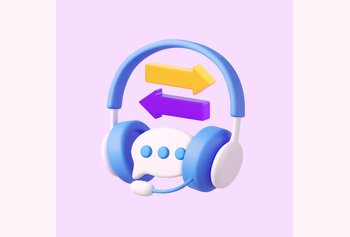7 Help Desk Automations Every Business Needs to Know
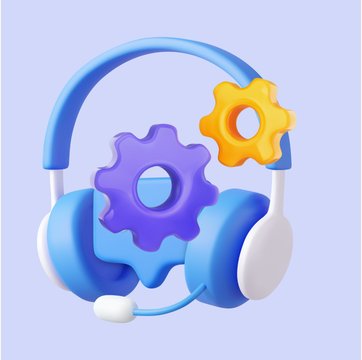
Table of contents
As customers, we’ve all become quite demanding. When you reach out to a business for some help, you’d expect them to respond as soon as possible and at the same time, you’d want the support staff to be warm and friendly.
These are fair expectations but let’s think about this from the standpoint of the business. They’re expected to deliver personalized support at scale. They’re getting hundreds if not thousands of queries from customers and they have to respond on time to each of them without compromising on the quality of support. How is this practically possible?
This is where you need to look inside your help desk, and tap into one of its most important features: automations.
Table of Contents
- What is Help Desk Automation?
- What is the Difference Between Help Desk Automation and Service Desk Automation?
- What Are the Benefits of Help Desk Automation?
- 7 Help Desk Automations Every Business Should Consider Implementing
- Tips to Follow When Implementing Help Desk Automation
- Conclusion
What is Help Desk Automation?
Help desk automation refers to the use of technology and software tools to streamline and optimize the processes and tasks commonly associated with customer support and service desks.
It aims to reduce manual effort, improve efficiency, enhance the customer experience, and allow support teams to focus on more complex issues that require human intervention.
A good example of help desk automation is what happens when a customer faces an issue. Say, they have trouble logging into their account.
- In this case, the customer raises a complaint with the concerned brand. An automated system now generates a support ticket with all the relevant customer information (ex. name, contact details, issue type, ticket number etc.).
- The ticket then gets assigned to a support agent based on certain pre-defined criteria. Once again, this is enabled by automation.
- Simultaneously the customer also receives an automated notification via email or SMS to let them know that their query has been received and a support agent is working to resolve the issue.
- When the issue is resolved, the customer is once again notified either by the agent or through an automated email. The help desk also sends out a feedback request automatically, that collects information about how satisfied the customer is with their support interactions.
As you can see, the entire sequence of steps that takes place from when a customer raises a ticket to when the issue is resolved can be automated. All your agents have to do is focus on resolving the support request at hand.
You May Also Like: Top 9 Free Help Desk Ticketing Systems of 2025
What is the Difference Between Help Desk Automation and Service Desk Automation?
A service desk is a tool designed to specifically help ITSM (IT service management) teams handle disruptions in IT service, manage service requests from users, coordinate technological changes, and keep track of an organization’s software and hardware assets.
Help desks, on the other hand, are designed to help support teams answer customer queries, provide resolutions, and keep track of user requests and issues. It provides a centralized system that enables support agents to interact with customers across channels like email, phone, chat, or knowledge base.
Although both service desk and help desk automation aim to improve the overall efficiency of support teams, there are a few key differences between both.
| Aspect of comparison | Service desk automation | Help desk automation |
|---|---|---|
| Scope | Focuses on automating IT service management activities. Examples include automatically prioritizing user reported incidents, automating approvals for IT processes, and triggering replacement requests for new software or hardware. | Focuses on automating support functions such as prioritizing customer queries, routing tickets to agents, configuring SLAs, and sending auto-responders. |
| Complexity | Quite complex since service desks have to be integrated with multiple IT systems such as asset management systems, enterprise resource planning solutions, and HRMS to set up user roles, access, and permissions. | Simpler and largely focused on ticketing and troubleshooting. Does not require extensive integrations. |
| Target users | Mostly for internal IT teams and some external users and customers. | Mostly used to support customers, partners, vendors, and other external stakeholders. |
What Are the Benefits of Help Desk Automation?
Help desk automation empowers businesses to provide better customer support while reducing costs and improving operational efficiency.
Here are some of the most significant benefits you can observe with help desk automation:
- Improved Efficiency: Automation streamlines repetitive tasks, such as ticket routing and categorization, allowing support teams to focus on more complex issues. This leads to faster response and resolution times.
- Cost Savings: By reducing manual labor and handling routine tasks with automation, companies can lower their operational costs. Fewer support agents may be needed to handle the same volume of inquiries.
- Consistency: Automation ensures consistent responses and actions, reducing the risk of human error. Customers receive standardized information and service, enhancing their experience.
- 24/7 Availability: Chatbots and automated responses can provide support around the clock, including outside of regular business hours, improving customer satisfaction and availability.
- Scalability: As businesses grow, they can easily scale their support operations with automation, handling increased ticket volumes without proportionally increasing staffing levels.
- Faster Resolution: Automation can prioritize and route tickets to the most appropriate support agents or teams, ensuring that urgent issues are addressed promptly.
- Reduced Workload: Support agents can focus on complex issues that require human intervention, leading to higher job satisfaction and better utilization of their skills.
- Compliance and SLA Adherence: Automation can help enforce service level agreements (SLAs) by tracking response and resolution times and sending alerts when SLA thresholds are at risk of being breached.
You Might Also Like: Everything You Need to Know About Automations in Hiver
7 Help Desk Automations Every Business Should Consider Implementing
Automating routine tasks not only boosts productivity but also ensures that every customer receives a consistent level of service. Here are some examples of help desk automation that every business should consider implementing:
1. Ticket Assignment Automation
Ticket assignment automations can significantly streamline support operations by optimizing the process of distributing incoming support requests (tickets) to the most appropriate agents or teams.
Here are the different types of ticket assignment automations:
Automated Categorization: When a support ticket is created, automated systems can analyze the content and categorize it based on predefined rules.
Example: A ticket related to a technical issue can be automatically categorized as “Technical Support,” while a billing query can be categorized as “Billing.”
Routing Based on Skills: Ticket assignment automation can consider the skills and expertise of support agents.
Example: Hiver’s Skill-Based Auto Assignment allows you to assign incoming customer conversations to agents based on their skill set.
For instance, emails containing the word ‘Reimbursement’ will be assigned only to payroll specialists in the Finance team.
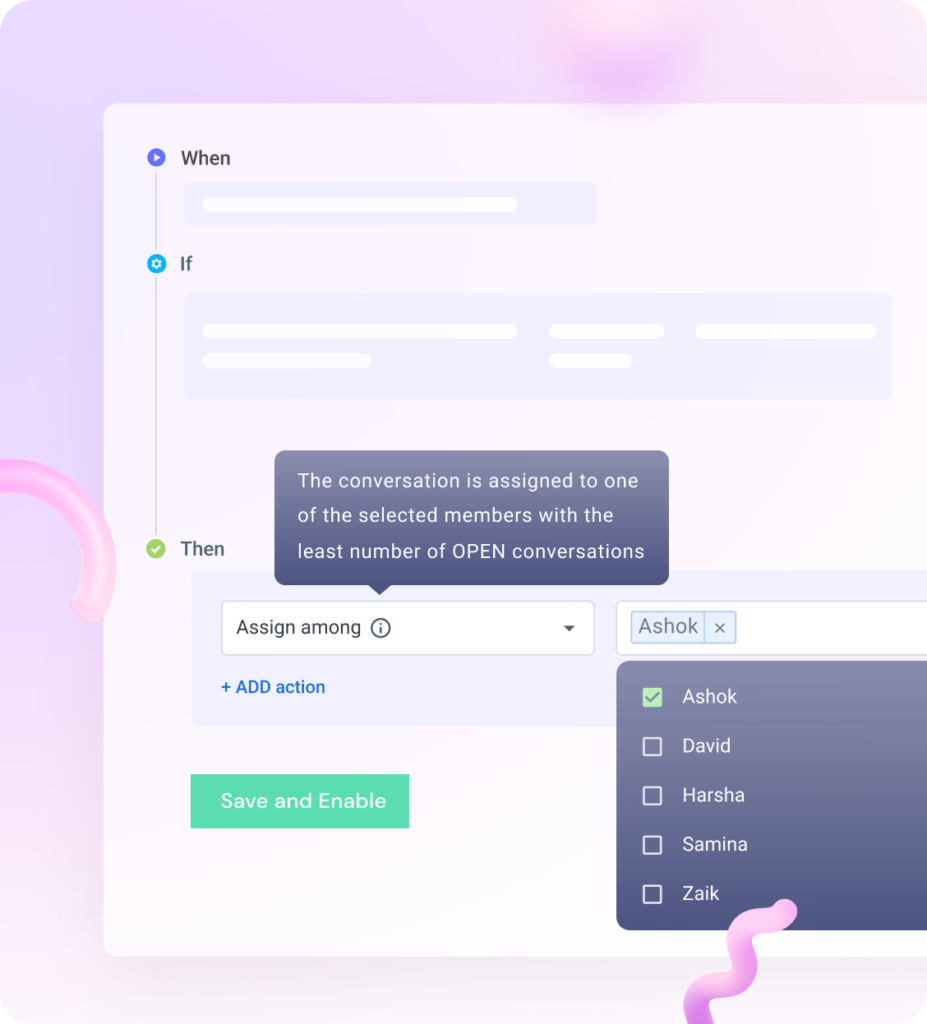
Priority-Based Routing: Automation can help assign priority levels to tickets based on their urgency or impact on customers. High-priority tickets can be routed to senior agents or specialized teams, while lower-priority issues can be handled by less-experienced agents.
Example: Let’s say the customer support team is divided into three segments with each handling one of three priority levels – High (ex. system outages),Medium (ex. software bugs),or Low (ex. UI glitches).
Priority-based routing automatically assigns a priority level to every incoming customer request and then these requests are routed to the team responsible for handling the respective request.
Round-Robin Assignment: In situations where all agents have similar skill levels, a round-robin assignment method can be automated. Each new ticket is assigned to the next available agent in a rotating sequence, ensuring an equitable distribution of workload.
Example: Hiver’s Round Robin Assignment ensures incoming requests are distributed in an equal manner. This optimizes team workload and also ensures every request gets a dedicated owner assigned to it.

Workload Distribution: Automation systems can monitor the workload of support agents and distribute tickets evenly to prevent overloading specific individuals or teams. This helps maintain service levels during high-demand periods.
Example: Say a support agent is unavailable to take up customer requests for a day and their status is set to ‘Away from Desk’. When a customer raises a ticket, the automated system monitors the availability of agents and redistributes the requests accordingly.
You Might Also Like: 9 Ways to Manage Email Service Queues
2. Email Automation
This help desk automation involves defining a set of rules and conditions that activate email messages in response to specific actions. This allows you to send highly targeted and personalized emails to your audience in a scheduled manner.
Aside from this, email automation can be used to send emails to users based on certain actions. For instance, a payment confirmation email is automatically sent when a customer successfully completes a payment transaction
Here are some of the most common email automation triggers and how they can help:
- Subscription or Sign-Up: When a user subscribes to a newsletter, creates an account, or signs up for updates, it can trigger a welcome email or a series of onboarding emails.
- Abandoned Cart: In e-commerce, when a customer adds items to their cart but doesn’t complete the purchase, it can trigger an abandoned cart email to encourage them to return and finalize their order.
- Purchase Confirmation: After a customer successfully completes a purchase, a confirmation email is triggered to acknowledge the transaction and provide details of the order.
- Form Submissions: When a user submits a form on your website, it can trigger an automated response or follow-up email, such as a thank-you message or a request for further information.
- Feedback Surveys: After a customer support interaction or a purchase, automated feedback survey emails can be triggered to collect customer opinions and improve services.
- Time-Based Triggers: Sending emails at specific times, such as weekly newsletters or monthly updates, can be triggered by a predefined schedule.
- Engagement Levels: Changes in a subscriber’s engagement level, such as increase or decrease in interactions, can trigger tailored emails to re-engage or nurture the relationship.
3. Knowledge Base Automation
A knowledge base is a centralized repository of information, documents, articles, FAQs, and other resources that provide answers to common questions and support for customers, employees, or users.
Knowledge base automation leverages AI to recommend relevant help articles or resources from a company’s knowledge base to customers any time they enter a query.
Knowledge base automation enhances self-service and increases customer satisfaction.
For instance, Hiver’s Knowledge Base allows you to easily create and update help articles. Customers can use the search bar embedded in the knowledge base to find relevant information. In cases where they are not able to find a proper answer, they can create a support ticket from right inside the knowledge base.
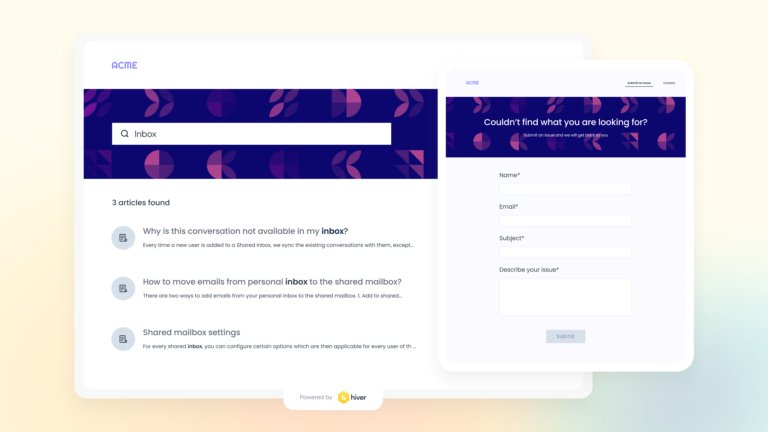
You Might Also Like: 10 Best Knowledge Base Software for 2025
4. SLA Automation
Service Level Agreements or SLAs are formal commitments made by a business or support team to its customers regarding the level of service they can expect to receive.
They play a crucial role in setting expectations, measuring performance, and ensuring a high level of customer satisfaction.
SLA automations in help desks allow you to set up reminder alerts so that any time a deadline is violated, the relevant teams are notified, ensuring timely resolutions. These reminder alerts are defined based on parameters like ticket type, severity of the issue, priority level, etc.
For instance, with Hiver’s SLA Management you can easily configure conditions to prioritize and track email responses. Say a customer query has to be responded to within the first two hours of receiving it. If this SLA is violated, relevant stakeholders are automatically notified with an ‘SLA Violation’ tag on the query.
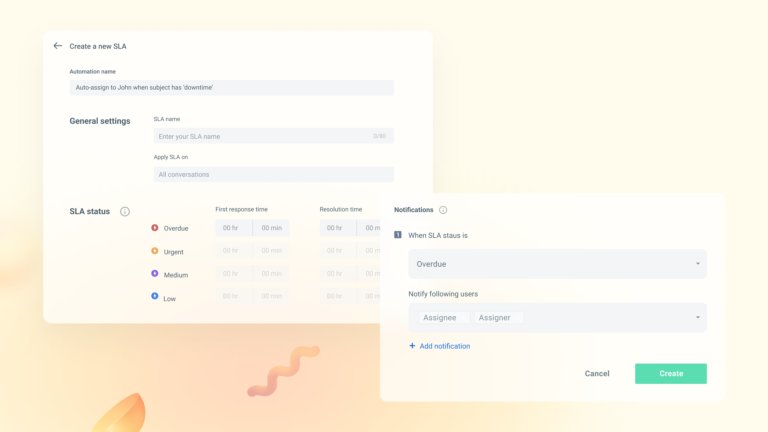
5. Customer Feedback Automation
This type of help desk automation uses predefined workflows to collect, analyze, and act upon customer feedback efficiently and effectively. It helps businesses streamline the feedback process, gain valuable insights, and enhance customer satisfaction.
Customer feedback automation enables help desks to automatically send out surveys after a support interaction or purchase.
The feedback can then be analyzed using NLP and sentiment analysis to extract essential information from unstructured responses.
For example, say a software company wants to collect feedback from customers who have recently used their mobile app. They want to understand the user experience, identify any issues, and gather suggestions for improvement.
In this case collecting the automation workflow would something like this:
- The customer completes an interaction with the mobile app. This triggers an email survey to the customer’s registered email address.
- The survey could be around the user’s satisfaction with the application, specific features they liked, issues they encountered, etc.
- Once the customer submits the survey, an automation tool like Chorus AI ( a tool that analyzes all customer interactions to identify top customers and extract important information to be used as testimonials) collects responses and categorizes them. For instance, the feedback can be related to the app’s features such as performance, user interface, features they liked, etc.
- If a customer rates an experience below a certain threshold, an automated alert is sent to the support team for immediate attention.
- The automated system then generates reports and dashboards that provide an overview of customer feedback trends. It highlights areas of concern and showcases positive feedback as well.
- For customers who provide contact information, the system triggers automated follow-up emails or notifications. These may include thanking the customer for their feedback, updating them on issue resolutions, or even offering incentives for participation.
You Might Also Like: Customer Feedback: How to Collect and What to Do With It
6. Escalation Automation
Escalation automation is the automated process of routing customer inquiries, issues, or tickets to higher levels of support or management when certain criteria are met.
This ensures that more complex or critical issues are handled promptly by the appropriate team or individual.
Escalation can involve multiple tiers, with each tier representing a higher level of expertise or authority. If an issue cannot be resolved at one tier, it escalates to the next until it reaches a resolution.
For example, when a customer reports a critical software bug, the system evaluates the severity of the bug based on predefined criteria. If it’s categorized as a high-severity bug that affects multiple customers, the system triggers an automatic escalation.
The ticket is routed from the general support team to the technical support team.
Notifications are sent to the technical support manager and relevant developers.
If the issue is not resolved within the defined SLA timeframe, it can further escalate to top-level management or a specialized engineering team.
You Might Also Like: Escalation Management: The Key to Handling Customer Service Requests More Effectively
7. Custom Workflow Automation
Custom workflow automation involves designing and implementing personalized and tailored automated processes within an organization’s operations or software systems.
These workflows are customized to meet specific business needs, allowing for the automation of unique tasks, actions, and decisions.
Custom workflows can streamline and automate complex processes, reducing manual effort and the likelihood of errors. It enables you to create workflows that precisely match your unique business processes, making it easier to adapt to changing needs.
Here’s an example of how this help desk automation can help.
Consider an e-commerce company that wants to automate its order fulfillment process, which includes order verification, inventory check, shipping label generation, and customer notification. This is how the custom workflow automation can be set up:
- Order Verification: The workflow starts when a new order is received. An automated system checks if the order information is complete and accurate.
- Inventory Check: The workflow checks the inventory system to ensure that the ordered products are in stock. If not, it triggers an alert to restock.
- Shipping Label Generation: Once the order is verified and the inventory check is successful, the system generates a shipping label and assigns the order to the shipping department.
- Customer Notification: After the order is shipped, the system automatically sends a confirmation email to the customer, including tracking information.
- Exception Handling: If any issues arise during the process (e.g., an out-of-stock item),the workflow can trigger notifications to relevant staff for manual intervention.
Tips to Follow When Implementing Help Desk Automation
Here are some best practices to keep in mind when implementing help desk automation.
- Identify what you want to automate: Sit with your support team and figure out tasks that are repetitive in nature and costing your agents their bandwidth. Make a note of these tasks and identify which ones can be easily automated.
- Choose the right tools: If you’re going for an automation tool, make sure to choose one that aligns with your specific objectives and fits within your budget.
- Consider potential challenges: While automation can streamline your workflow, it can also introduce new problems. For instance, your staff may need ongoing support and training to get used to the new workflow. Brainstorm with your team to figure out such challenges and make a plan of action to tackle these before plunging into implementation.
- Start small: Instead of automating complex tasks right from the start, try to focus on implementing it for smaller activities. Test out how the automation is performing and assess how comfortable your team members are with the workflow. Gradually expand as your team becomes more proficient. For instance, you can start with automating something as simple as ticket assignment and then once that is successful, you can move on to automatic ticket routing, escalation, and SLA monitoring.
Conclusion
Imagine your team working smarter, not harder. Help desk automations help you do exactly that. No more drowning in routine tasks, no more customer inquiries slipping through the cracks.
Help desk automations not only help you save time and money – but they also enable you to deliver top-notch service. It empowers businesses to enhance their efficiency, boost customer satisfaction, and stay competitive in today’s fast-paced environment.













